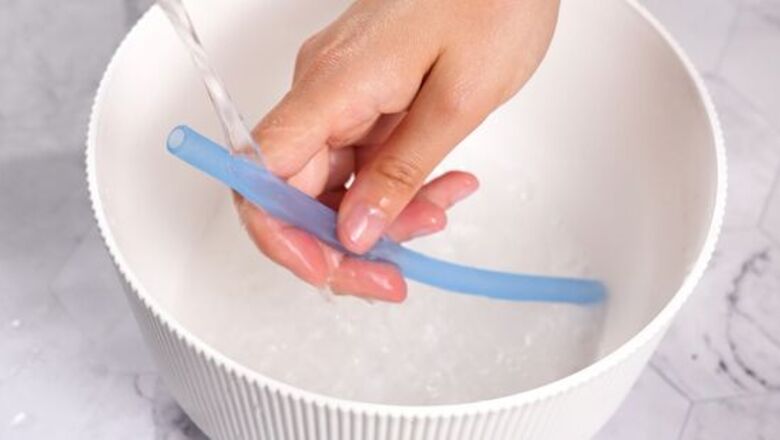
views
Cleaning Reusable Straws with a Straw Cleaner
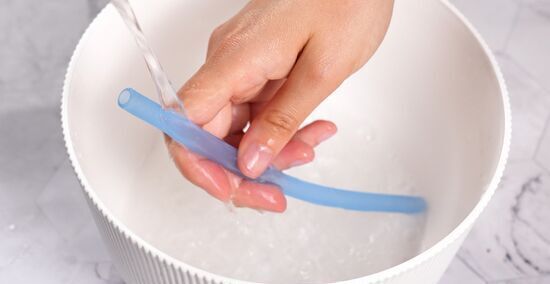
Rinse your straw with hot water to loosen debris. Rinse the straw right after using it to keep new debris from caking on the inside. Cover the bottom end with a finger and run hot water through the top. Then, remove your finger and let the water run all the way through. If you notice chunky bits, plug the bottom hole, fill it with water, then blow through the top to dislodge them. Meet the wikiHow Expert Susan Stocker is a professional cleaner with over 10 years of experience. She’s cleaned for 1000+ clients, specializing in reduced-carbon-emissions cleaning.
Add dish soap to your straw cleaner, then insert and scrub vigorously. Squirt a few drops of dish soap onto a pipe cleaner or cleaning brush. Use whatever dish soap you have on hand. Insert your straw cleaner and pull it back and forth a few times to clean out any hidden material in the straw. If there’s extra stubborn gunk inside that won’t come out, Stocker suggests soaking the straw in a mix of equal parts water and vinegar with a splash of lemon juice overnight. In the morning, rinse it with a hard hose in your sink to dislodge the gunk. If you are using a cleaner that isn’t long enough, insert it at both ends to clean. Or, twist 2-3 together to get the desired length. Twist them tightly so they don’t fall off inside the straw. Try a dish soap that contains natural ingredients if you are worried about ingesting soap residue. Add baking soda to your brush and rescrub the inside if you still see debris that won’t dislodge.
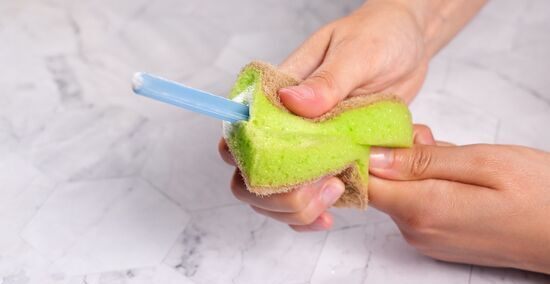
Scrub the outside of the straw with a sponge, then rinse. Don’t forget to give the outside a quick scrub to make sure it’s clean, as well. Use dish soap and a sponge to scrub the outside of the straw. After scrubbing, rinse the soap off using warm water. If you don’t have a sponge available, soap up your hands and scrub the outside of the straw with your fingers. Rinse the inside of the straw under warm water to remove the soap, too.
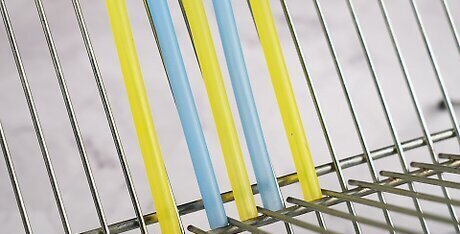
Place the straw in an upright position so it can dry completely. Standing your straw in an upright position will allow excess water to drain out, letting the straw dry completely. Avoid mildew by letting your straw dry before putting it away. Use a drying rack to help your straw stay upright by leaning it against the metal frame.
Cleaning Reusable Straws without a Straw Cleaner
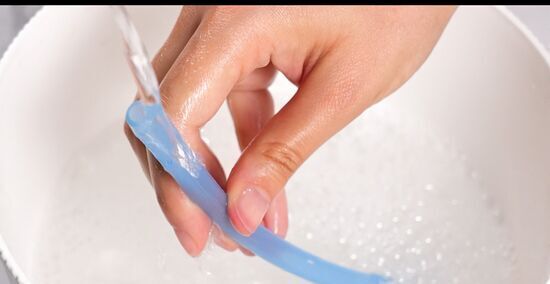
Run hot water through the straw as soon as you are done using it. If you don’t have a pipe cleaner or brush, it is best to rinse out your reusable straw immediately after use. If the straw sits for too long, the liquid you were drinking will dry and cake onto the inside of the straw, making it much harder to clean. Rushing hot water through the straw immediately after use can clean it out nicely. If you can't immediately rinse your straw, stick it into a water bottle and take a few sips of water. While this is not as effective as hot water, it is better than nothing.
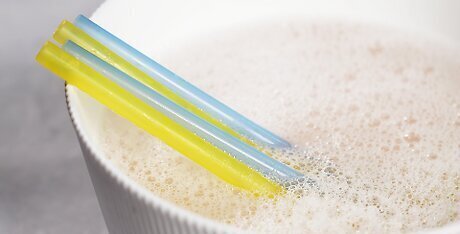
Soak the straw in warm, soapy water, then rinse it completely. According to Stocker, soaking your straw in warm, soapy water can help break up any material stuck inside the straw. Soak the straw for anywhere from a few minutes to several hours. Once you're done, run hot water through and over the outside of the straw to rinse out any loosened residue that might still be stuck in the straw. Try filling a large mason jar with warm, soapy water and add the straw. Cap the jar and shake it thoroughly to help dislodge material. Then, rinse out the straw until all of the soap is removed. When cleaning bamboo straws, this is the best method to use.
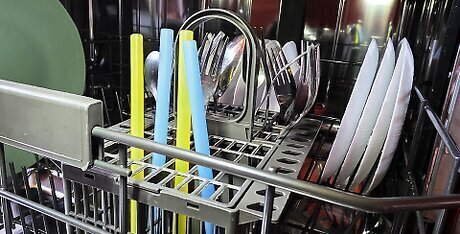
Run the straw through the dishwasher. Most straws are dishwasher safe, but it is best to check the manufacturer's instructions for the straw you are trying to clean. Once you’re confident your straw is dishwasher safe, place the straw in the bulk utensil section and run the dishwasher. When clean, make sure the straw stands upright long enough for it to dry out completely. Stainless steel straws and glass straws do well in the dishwasher. Bamboo straws, on the other hand, should just be soaked and rinsed. According to Stocker, putting straws in the dishwasher is a great way to clean reusable straws.
Where to Buy Straw Cleaners

Buy straw cleaners online or from big box stores like Amazon or Walmart. Straw cleaners tend to come in packs ranging from 2-9 cleaners of different sizes and are available at places like Amazon, Walmart, Target, and Walgreens. Some straw cleaners even come in kits that include different-shaped cleaners, as well! They typically go anywhere from $5-$15, depending on the type of cleaner you buy. Some of our favorite straw cleaners include: 4-Set of Heavy Duty Cleaning Brushes 10-Piece Reusable Straw Cleaners (Extra Long) Dawn Straw Cleaning Brush for Reusable Straws (4-Pack) 5-Pack Bottle Brush & Straw Cleaner Kit 10-inch Straw Cleaning Brush for Stanley Cups
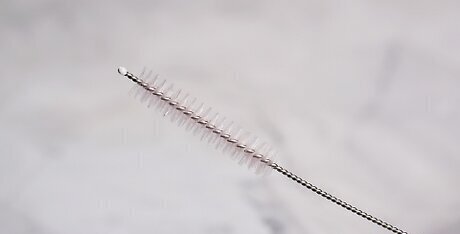
Or, buy pipe cleaners from your local crafts store. Pipe cleaners are available at craft stores like Michaels, Staples, and Ace Hardware. They’re typically in stock everywhere, as they have many common uses, from pipe cleaning to crafts for kids. They tend to be affordable, too, with packs of pipe cleaners typically going for $1-$8, depending on the size.
Which straws are easiest to clean?
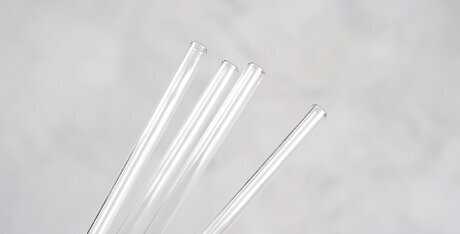
Glass straws Since you can see through glass straws, the debris, gunk, and buildup are easier to spot. Although you’ll still need to use a straw cleaner to get in there and remove everything, being able to see will make the cleaning process much easier, as you won’t be shooting in the dark and wiping blindly.
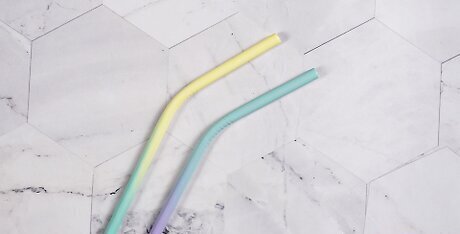
Boilable straws Straws that you can boil are much easier to clean than your standard reusable straw. Boiling water helps get rid of contaminants, kill germs, and break down debris in the straw, making it much easier to rinse and clean as opposed to using a straw cleaner. You may still need a straw cleaner for gunk that’s extra tough or dense, but it’s not guaranteed. Glass and metal straws are typically boilable, while rubber and plastic straws aren’t.
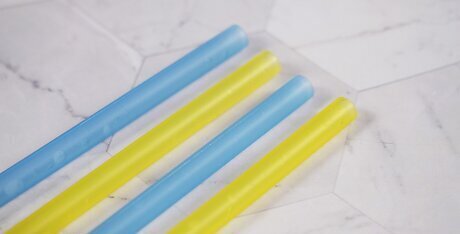
Rubber straws Rubber straws provide more flexibility than glass or metal reusable straws, as they can be bent and reshaped to fit your cleaning needs. Say you’re washing a rubber straw that has gunk built up in the middle. By bending the straw and squeezing from the middle down, you’ll be able to dislodge the gunk more easily than if you were cleaning an inflexible metal or glass straw.











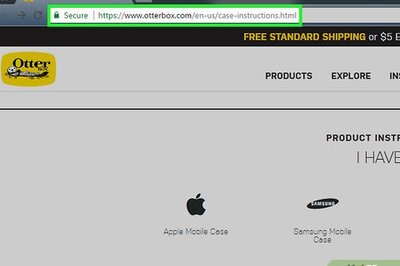

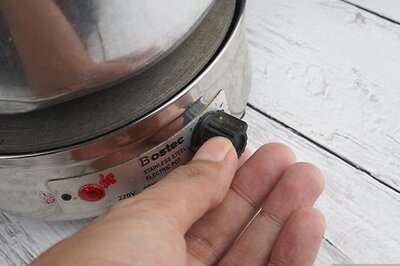



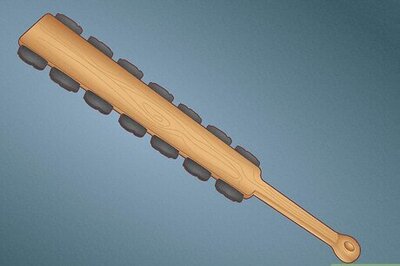
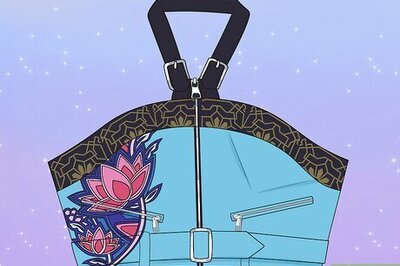

Comments
0 comment